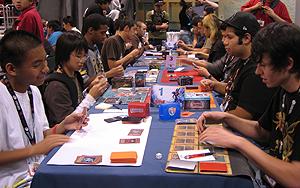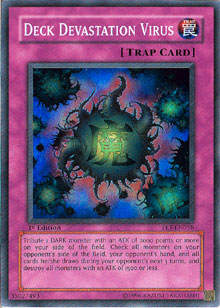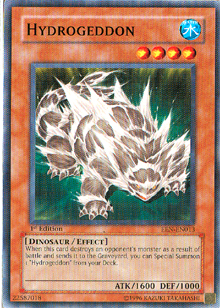Did you see that? Did you SEE that?
 Shonen Jump Championship Anaheim was everything the dueling community hoped for and then some. Being on the tournament floor to see the epicenter of the North American metagame as it changed was a blast, and even though Monarchs eked out another win (and narrowly at that), things have clearly changed. Jerome already did a great job outlining major deck trends in his article yesterday. Back-to-back victories for Thestalos brought Dark World back into the fold, and the success of Mystic Tomato and Treeborn Frog made Dimensional Fissure a winner for Kirk Leonhardt. A metagame full of monster exchanges and big beatsticks even made Creature Swap a surprise hit. Matt Peddle will discuss Theeresak Poonsombat’s success with Dark World more this coming Sunday, so with the Top 8 decks covered, I’d like to take a closer look at some of the major single cards that had breakout showings for this format.
Shonen Jump Championship Anaheim was everything the dueling community hoped for and then some. Being on the tournament floor to see the epicenter of the North American metagame as it changed was a blast, and even though Monarchs eked out another win (and narrowly at that), things have clearly changed. Jerome already did a great job outlining major deck trends in his article yesterday. Back-to-back victories for Thestalos brought Dark World back into the fold, and the success of Mystic Tomato and Treeborn Frog made Dimensional Fissure a winner for Kirk Leonhardt. A metagame full of monster exchanges and big beatsticks even made Creature Swap a surprise hit. Matt Peddle will discuss Theeresak Poonsombat’s success with Dark World more this coming Sunday, so with the Top 8 decks covered, I’d like to take a closer look at some of the major single cards that had breakout showings for this format.
Ready? Let’s go.
Deck Devastation Virus was a somewhat popular side-deck pick for the earlier months of the current Advanced. While it was virtually useless in the aggro beatdown matchup, it was of superior strategic worth against Warrior toolbox and some Monarchs. As the Monarch build pioneered by Lazaro Bellido at Shonen Jump Championship Boston (which was then further evolved by Ryan Spicer and Kyle Lopez at successive SJCs) became mainstream, the deck’s reliance on Apprentice Magician and the engine it supports created a structural vulnerability. While there were differences between each Monarch build run by Bellido, Spicer, and Lopez, they shared one interesting thing in common: all three decks had exactly thirteen monsters that could be discarded or destroyed by Deck Devastation Virus. That’s more than half of the 23 monsters that each version adhered to. Seeing as each deck also used six Monarchs, Deck Devastation Virus alienates all but four monsters from being used, barring Treeborn Frog.
 Four monsters to live and die by. That’s what Deck Devastation Virus reduces the format’s most dominant deck to. That observation carried Theeresak Poonsombat to a Top 4 finish in Anaheim, but I have the feeling that it will take another duelist to an even greater victory by the time this format has concluded. The best part? The Virus isn’t exclusive to Dark World strategies. It also fits well into Fiends, where it can be supported by Dark Necrofear and Giant Orc, or Spellcasters with Magical Marionette and Dark Elf. While main-decked Deck Devastation Virus takes a lot of guts to commit to, the proof is in the Top 8, and this is one trend that I think we’ll see more of. Monarch players will have to adapt to this interesting turn of events.
Four monsters to live and die by. That’s what Deck Devastation Virus reduces the format’s most dominant deck to. That observation carried Theeresak Poonsombat to a Top 4 finish in Anaheim, but I have the feeling that it will take another duelist to an even greater victory by the time this format has concluded. The best part? The Virus isn’t exclusive to Dark World strategies. It also fits well into Fiends, where it can be supported by Dark Necrofear and Giant Orc, or Spellcasters with Magical Marionette and Dark Elf. While main-decked Deck Devastation Virus takes a lot of guts to commit to, the proof is in the Top 8, and this is one trend that I think we’ll see more of. Monarch players will have to adapt to this interesting turn of events.
Megamorph was perhaps even more shocking, strictly in a “Why didn’t we see that before?” sense. While Team Overdose got the most press for their unorthodox use of this overly-pigeonholed card, many more local players had caught on to a similar conclusion: Megamorph can win games with more than just Cyber-Stein. Some duels in this format come down to who controls the biggest monster the longest, and Megamorph can make even Dekoichi the Battlechanted Locomotive into a Monarch-stomping terror. If you’re the one controlling a Monarch or Cyber Dragon, then Megamorph can boost it to huge ATK values, and a quick swing in momentum can mean a direct attack for more than 4000 life points, often enough for game.
This is something that Cyber-Stein duelists obviously noted long ago, as attacking with a boosted Cyber Dragon (either by way of Limiter Removal or Megamorph) is nothing new. The interesting part is what the rise of Megamorph might mean for other decks. Quite often, players in this format will over-extend early on to score fast damage and drive the opponent below 5000 life points, whether or not they have pre-existing knowledge of a Cyber-Stein risk. That leaves the attacked duelist with fewer life points, but usually more remaining options. If at this point Megamorph comes into the picture, it can create a dominating field presence that’s difficult for the initial aggressor to stand against (especially if his or her aggressive thrust used up cards like Smashing Ground or Sakuretsu Armor that could otherwise stop the pumped attacker). Situations like those seen at the end of Mark Garcia and Lance Leonhardt’s Anaheim feature match are a perfect example of this type of situation: Garcia committed Heavy Storm, Cyber Dragon, Dark World Lightning and Goldd, Wu-Lord of Dark World to make an early push, and when Lance fought back with Megamorph, Garcia was out of answers. Garcia’s one saving grace, Mirror Force, was easily dealt with and Lance swung directly with a ’morphed Cyber Dragon for game. It’s a situation that we might see cropping up more frequently.
Finally, the sudden rise of Strike Ninja was tremendous. At one point a walk of the top ten tables allowed me to see the Ninja on three or four fields: astounding given the lack of play the monster had seen in Seattle and Austin. The play conditions that make Strike Ninja an advantageous pick simply weren’t present earlier in the format. In Anaheim, the metagame was more favorable, and the progression is pretty easy to see in retrospect.
While Hydrogeddon came out swinging in Boston and then solidified itself as a force in Austin, it took a while for trap lineups to react accordingly. With Hydrogeddon and Cyber Dragon fuelling incredibly aggressive tempos, it was only a matter of time before the choice of two to three specialized monster removal traps (like Sakuretsu Armor or Bottomless Trap Hole) became a choice of three, four, or five instead. A lot of competitors in Anaheim were packing three Sakuretsu Armor cards and multiple copies of Bottomless Trap Hole or Widespread Ruin. That increased the play value of Strike Ninja dramatically, which already had the ability to alienate format favorites like Enemy Controller, Ring of Destruction, and Brain Control. Add Mirror Force and Zaborg the Thunder Monarch played into a Ninja-only field, and you’ve got a format where Strike suddenly outplays eight, ten, or even twelve cards in the average opposing deck.
Of course, Strike Ninja didn’t get into the Top 8 and thus might not make a significant appearance at San Jose, so its future is kind of dodgy (no pun intended). Whether or not it will become an enduring figure in the format is completely up in the air, but it’s a trend I’ll be keeping a careful eye on two-and-a-half weeks from now at the next SJC. The fact that Strike Ninja happens to be large enough to take down Hydrogeddon is certainly a vote in its favor, which brings us to this installment’s Plays to Make.
Plays to Make: Beating Hydrogeddon
 Teching aggressive strategies (and Hydrogeddon itself) has become an ingrained part of the format. As I mentioned earlier, the rise in trap-based removal is due in part to Hydrogeddon’s popularity, as is the continued use of Asura Priest. In fact, following that train of thought, a link might even be drawn to the strong showing of Creature Swap in Anaheim. Hydrogeddon (and the aggressive play style it represents) has set major trends: that’s beyond debate. What is debatable though, is the question of the card’s greatest impact. Personally, I think the answer rests in Apprentice Magician.
Teching aggressive strategies (and Hydrogeddon itself) has become an ingrained part of the format. As I mentioned earlier, the rise in trap-based removal is due in part to Hydrogeddon’s popularity, as is the continued use of Asura Priest. In fact, following that train of thought, a link might even be drawn to the strong showing of Creature Swap in Anaheim. Hydrogeddon (and the aggressive play style it represents) has set major trends: that’s beyond debate. What is debatable though, is the question of the card’s greatest impact. Personally, I think the answer rests in Apprentice Magician.
One of the big rulings questions that continually arose in Boston was that of Hydrogeddon versus Newdoria, and how it related to Hydrogeddon’s interaction with Old Vindictive Magician. We’ve never had much of a place to highlight these plays and their outcomes on Metagame.com, so I’m prioritizing the discussion of it here in this article.
While both Newdoria and Old Vindictive Magician get to destroy a monster when attacked by Hydrogeddon, they do so at different times and in different ways. In order to understand both situations, one fact must first be made clear: Hydrogeddon needs to be on the field in order for its effect to resolve. Destroy a spell or trap after its effect has been activated and you do nothing to prevent its resolution, but the same can’t be said for many monster effects. Hydrogeddon is one of them, so when it’s destroyed by Old Vindictive Magician it can’t bring another Hydro to the field even though it will destroy Vindictive with its attack. By playing Apprentice Magician, you open up a tactical suite of options, and one of them (Old Vindictive) lets you stop one of the format’s big threats.
Newdoria works differently, triggering at the same time as Hydrogeddon’s effect, when Newdoria hits the graveyard. As a result, both effects form a chain. Newdoria’s effect is mandatory, so it will be added to the chain first. By the time it resolves, the first Hydrogeddon will have already brought the second to the field. More than that, Newdoria’s effect requires a target at activation, and at that point the second Hydro won’t be on the field yet. That means Newdoria can only destroy the first Hydro—the one that’s already attacked—so it does little to stop the onslaught. Since Newdoria doesn’t provide tactical value against Hydrogeddon, Old Vindictive is a superior choice.
That, combined with the ability to work around global remove-from-game effects that would stymie Mystic Tomato, has made Apprentice Magician exceptionally popular. Though Tomato is still played, Apprentice engines seem to gain popularity in every SJC. If you’re one of the duelists running it, remember how valuable it can be against Hydrogeddon. The number-one spot for Apprentice Magician right now is in Monarch builds, and ruthless aggression is the biggest natural enemy of such a strategy. Exploit your tactical options to their full extent and you can get an edge over the competition.
That’s it for this installment of Trends ‘N’ Tactics, but I’ll be back in two weeks with one last article before Shonen Jump Championship San Jose!
—Jason Grabher-Meyer